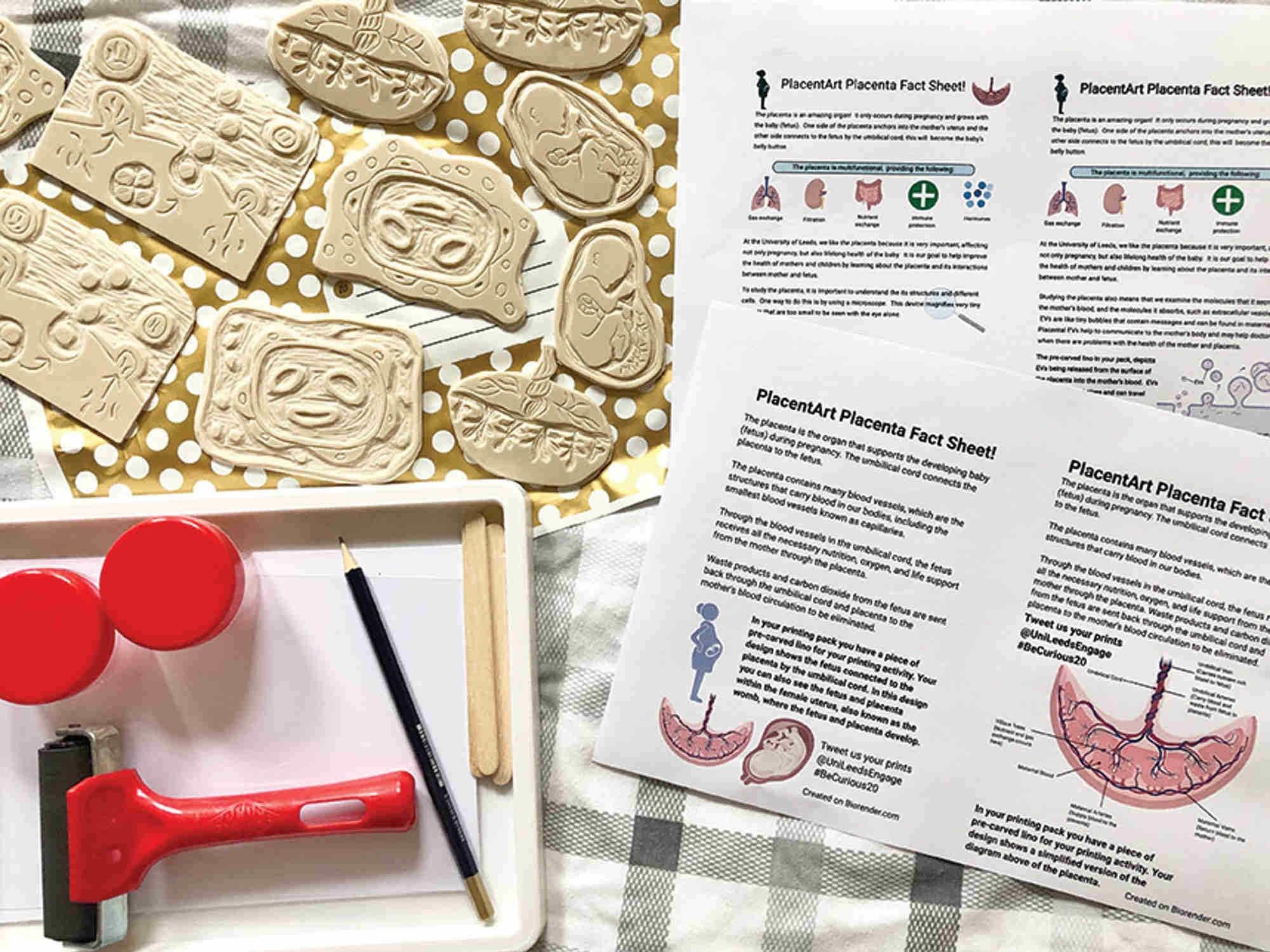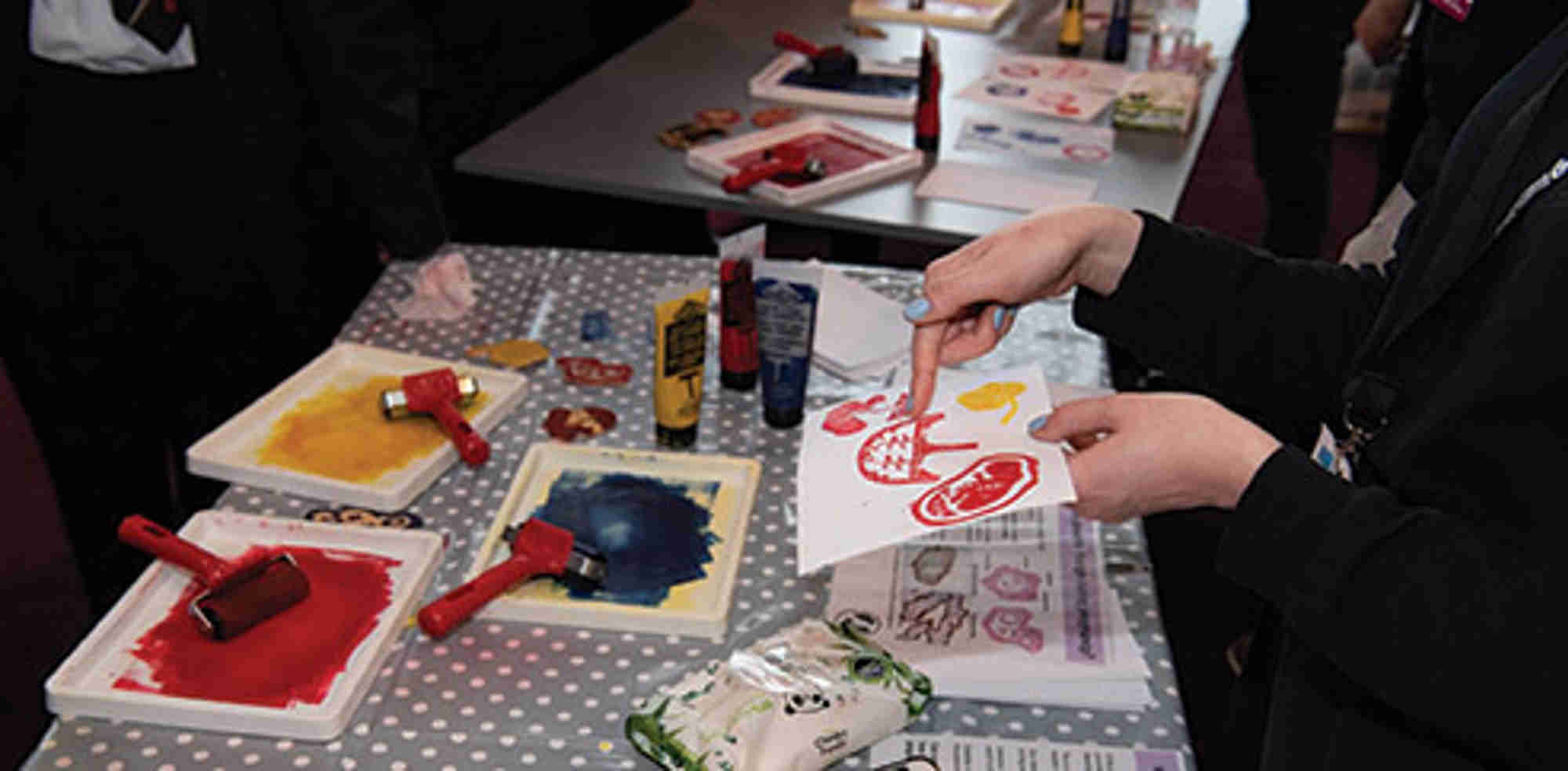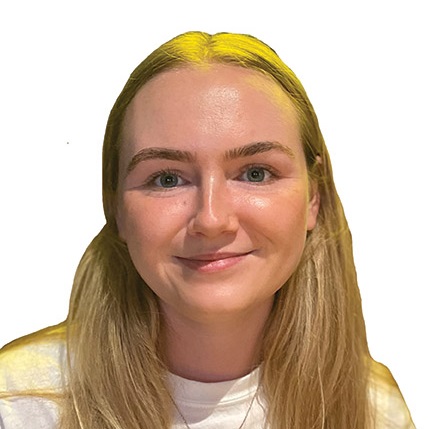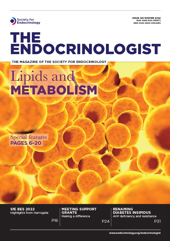As a PhD student at the University of Leeds, I am a part of the Forbes and Scott labs, and the Leeds Pregnancy Research Group. Collectively, we investigate healthy pregnancies as well as those affected by gestational disorders, such as diabetes and complications of fetal growth. This research is important because these disorders can lead to increased risk of birth complications and higher likelihood of cardiometabolic disease in later life, for the mother and the offspring.1,2
The placenta is a key endocrine organ, which releases hormones to maintain pregnancy and is highly vascularised to allow the transfer of nutrients from the maternal to the fetal circulation to support the growing fetus.3,4 My research investigates how diabetes in pregnancy can cause the blood vessels in the placenta to develop differently, and how this might be linked to complications for mother and baby.
PUBLIC OUTREACH AND PRINTMAKING
Alongside our research, we regularly take part in public outreach events, to promote awareness of the importance of health during pregnancy, and how this can be a determinant of adult health. Through these experiences, I developed my own activity: ‘PlacentArt’. This art activity demonstrates placental blood flow, endocrine function and the vascular structure of the placenta in normal and diabetic pregnancies, through mono- and lino printing.
This stemmed from my own interest in printmaking, which started during a Christmas card lino printing workshop I attended in 2019. I began regularly creating lino prints during the first COVID-19 lockdown in 2020. The subject of these prints was mainly flowers and plants. I opened my own online shop (see @AbbieByfordPrints on Instagram) and ran stalls at craft fairs.

PlacentArt printing packs
ENGAGING THE PUBLIC VIRTUALLY
I planned to conduct the PlacentArt activity at the 2020 University of Leeds Be Curious festival. This annual, open access, free event showcases research across the University through a range of interactive activities, with a target demographic of families.5 The 2020 event was cancelled due to the lockdown, so I adapted my activity so that it could be done virtually, with items that were easily available at home. I created downloadable materials, including how to monoprint using sandwich bags, paint, paper and cottonwool buds.
'I began regularly creating lino prints during the first COVID-19 lockdown in 2020. The subject of these prints was mainly flowers and plants. I opened my own online shop and ran stalls at craft fairs.'
A few months later, I worked with the University’s Public Engagement Team to send out 10 packs of printing equipment to people in the Leeds area for them to try lino printing. These included placenta factsheets, lino (which was pre-carved with placental structures), printing ink, a printing tray, a roller for the ink, paper, and acetate and pencils for monoprinting. I had support from Rachel Quilang, a post-doctoral researcher in our lab, who helped carve designs into the lino. Alongside this, I created an accompanying demonstration video, which covered the simple and more detailed mono- and lino printing.6
Through these virtual events, I adapted my original activity to various printing methods suitable for different age groups. This video and other resources have also been used for other virtual events, including STEM Clubs UK, and the Global Science Show on Twitter.
ENGAGING THE PUBLIC IN PERSON
I have since received a Public Engagement Grant from the Society for Endocrinology, in addition to a grant from the Pathological Society (with Dr Lara Morley), which has allowed me to participate in face-to-face events.
In May 2022, the University of Leeds Be Curious festival took place in person again. Around 1,200 people visited the event and 160 staff/students took part. The Leeds Pregnancy Research Group held a stall at this festival entitled ‘Womb for improvement’. We conducted a range of activities, including PlacentArt. I pre-carved lino with different placental structures (such as overall structure, cross sections, and diabetic and non-diabetic placentas) prior to the event. These could be used as stamps, for participants to apply ink to and print onto paper.
SfE BES 2022 SCHOOLS OUTREACH EVENT
During the schools outreach event at SfE BES 2022 in Harrogate, three local schools were invited to take part in activities to learn about the world of hormones, and to meet doctors, nurses and scientists.
I was pleased to be invited to conduct PlacentArt at this event. Students were between 14 and 16 years old, which allowed me to explain the cellular structure of the placenta in more detail. I used prints of a placenta cross section and related this to microscopy images of human placentas, which had been generated in our lab. I also highlighted the important role of the placenta in the production of pregnancy hormones, supporting the GCSE curriculum on hormones during reproduction and pregnancy. This also sparked discussions on careers in STEM (science, technology, engineering and mathematics).

Demonstrating PlacentArt to school pupils at SfE BES 2022 in Harrogate.
EVALUATING THE ACTIVITY
During these events I have collected feedback. I sent an online questionnaire to participants who received printing packs.
Comments showed that they had enjoyed the activity and learned something about the placenta. One person remarked, ‘[We] loved getting our package through the post – it was like getting a present … I have been meaning to attend the festival in previous years and never quite made it, even though we don’t live far from Uni. By having the festival online this year, it has allowed me to attend finally.’
By conducting this activity at both virtual and in-person events, it meant I was able to reach and communicate with more members of the public.
PERSONAL AND PROFESSIONAL GAIN
I have thoroughly enjoyed creating and conducting this activity. Using art has been a great way to enthuse all age groups in science, including children, and to educate them about the placenta and hormones. I also appreciate how much the participants enjoy making the prints.
It has also helped my career development, as I am now a member of the Society for Endocrinology Public Engagement Committee and I been invited to share my experiences at Public Engagement Workshops, including at the SfE BES conference 2020 and the International Federation of Placenta Associations conference 2021.
The Public Engagement Grant from the Society for Endocrinology will enable me to attend future events, in and outside of Leeds, including the Otley Science Festival and Nottingham Festival of Science and Curiosity, as well as Be Curious 2023.
Abigail R Byford
BHF 4-year PhD Programme Student, Leeds Institute of Cardiovascular and Metabolic Medicine, University of Leeds
REFERENCES
1. Jowell AR et al. 2022 JAMA Cardiology 7 346–355.
2. Fraser A & Lawlor DA 2014 Current Diabetes Reports 14 489.
3. Evain-Brion D & Malassine A 2003 Growth Hormone & IGF Research 13 34–37.
4. Chen DB & Zheng J 2014 Microcirculation 21 15–25.
5. University of Leeds 2022 Be Curious www.leeds.ac.uk/becurious.
6. Byford AR 2020 PlacentART @ #BeCurious20 www.youtube.com/watch?v=vkwCAmbYAJs.








